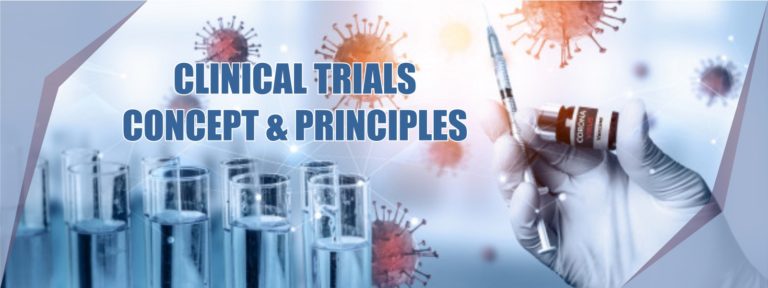Clinical Trials :
These are the
phases of
clinical research are the stages in which scientists conduct experiments with a health intervention to obtain sufficient evidence for a process considered effective as a
medical treatment.
Preclinical studies
As the pharmaceutical companies initiate clinical trials on a drug, they perform extensive preclinical investigation. These involve in vitro(test tube) and in vivo (cell culture) experiments preliminary efficacy, toxicity and pharmacokinetic information. Such tests helps
pharmaceutical companies to decide whether a drug candidate has scientific merit for further development as a new drug which is under investigation.
Phase 0
Main features of Phase 0 trials include the administration of single sub therapeutic doses of the study drug to a small number of subjects (10 to 15) to gather preliminary data on the agent’s pharmacokinetics (what the body does to the drugs).
A Phase 0 study gives no data on safety or efficacy, being by definition a dose too low to cause any therapeutic effect. Drug development companies carry out Phase 0 studies to rank drug candidates in order to decide which has the best pharmacokinetic parameters in humans to take forward into further development. They enable go/no-go decisions to be based on relevant human models instead of relying on sometimes inconsistent animal data.
Phase I
Phase I trials are designed to test the safety, side effects, best dose, and formulation method for the drug. Phase I trials are not randomized, and thus are vulnerable to selection bias.
Normally, trial will be done on a small group of 20–100 healthy volunteers. These trials are often conducted in a clinical trial area where the subject can be checked by full-time staff. These clinical trial clinics are often run by CRO’s who conduct these studies on behalf of pharmaceutical companies or other research investigators.
The subject who receives the drug is usually observed until several half-lives of the drug have passed. This phase is designed to assess the safety, tolerability, pharmacokinetics and pharmacodynamics of a drug. Before beginning a phase I trial, the sponsor must submit an Investigational new drug aplication to the FDA detailing the preliminary data on the drug gathered from cellular models and animal studies.
Phase II
After the fixing of the doses,, the next step to find out whether the drug has any biological activity
or effect. Phase II trials are performed on larger groups (50–300) and are designed to assess how well the drug works, as well as to continue Phase I safety assessments in a larger group of volunteers and patients. Genetic testing is common, particularly when there is evidence of variation in metabolic rate.
When the development process for a new drug fails, this usually occurs during Phase II trials when the drug is discovered not to work as planned, or to have toxic effects.
Phase III
This phase is designed to assess the effectiveness of the new intervention and, thereby, its value in clinical practice Phase III studies are randomized controlled multicentre trials on large patient groups (300–3,000 or more depending upon the disease/medical condition studied) and are aimed at being the definitive assessment of how effective the drug is, in comparison with current ‘gold standard’ treatment.
Because of their size and comparatively long duration, Phase III trials are the most expensive, time-consuming and difficult trials to design and run, especially in therapies for chronic medical conditions. This is sometimes called the “pre-marketing phase” because it actually measures consumer response to the drug.
It is common practice that certain Phase III trials will continue while the regulatory submission is pending at the appropriate regulatory agency. This allows patients to continue to receive possibly lifesaving drugs until the drug can be obtained by purchase.
Once a drug has proved satisfactory after Phase III trials, the trial results are usually combined into a large document containing a comprehensive description of the methods and results of human and animal studies, manufacturing procedures, formulation details, and shelf life.
This collection of information makes up the “regulatory submission” that is provided for review to the appropriate regulatory authorities in different countries. They will review the submission, and, it is hoped, give the sponsor approval to market the drug.
Most drugs undergoing Phase III clinical trials can be marketed under FDA norms with proper recommendations and guidelines through a new drug application (NDA) containing all manufacturing, preclinical, and
clinical data. In case of any adverse effects being reported anywhere, the drugs need to be recalled immediately from the market.
While most pharmaceutical companies refrain from this practice, it is not abnormal to see many drugs undergoing Phase III clinical trials in the market.
Phase IV
A Phase IV trial is also known as post marketing investigation trial. Phase IV trials involve the safety surveillance and ongoing technical support of a drug after it receives permission to be sold.
Phase IV studies may be required by regulatory authorities or may be undertaken by the sponsoring company for competitive (finding a new market for the drug) or other reasons (for example, the drug may not have been tested for interactions with other drugs, or on certain population groups such as pregnant women, who are unlikely to subject themselves to trials).
The safety surveillance is designed to detect any rare or long-term adverse effects over a much larger patient population and longer time period than was possible during the Phase I-III clinical trials. Harmful effects discovered by Phase IV trials may result in a drug being no longer sold, or restricted to certain uses.


